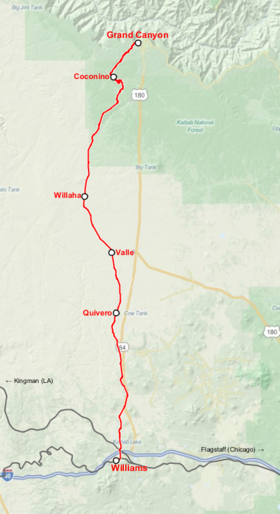Grand Canyon Railway
| Grand Canyon Railway | |
|---|---|
 |
|
 |
|
| Locomotive No. 4960 on the Grand Canyon Railway | |
| Locale | Coconino County, Arizona, USA |
| Terminus | Grand Canyon Village |
|
|
|
| Commercial operations | |
| Built by | Atchison, Topeka and Santa Fe Railway |
| Original gauge | 4 ft 8 1⁄2 in (1,435 mm) standard gauge |
| Preserved operations | |
| Owned by | Philip Anschutz |
| Operated by | Grand Canyon Railway |
| Reporting mark | GCRY |
| Preserved gauge | 4 ft 8 1⁄2 in (1,435 mm) standard gauge |
| Commercial history | |
| Opened | 1901 |
| Closed to passengers | 1968 |
| Closed | 1974 |
| Preservation history | |
| 1988 | Max and Thelma Biegert Ownership |
| 1989 | reopened |
| 2006 | Xanterra ownership |
| 2008 | Transition to steam operation |
| 2008 | Expansion proposals |
| 2008 | Philip Anschutz ownership |
| Headquarters | Williams |
| Website | |
| http://www.thetrain.com | |
| Grand Canyon Railway | |||||||||||||||||||||||||||||||||||||||||||||||||||||||||||||||||||||||||||||||||||||||||||||||||||||||||||||||||||||||||||||||||||||||||||||||||||||||||||||
|---|---|---|---|---|---|---|---|---|---|---|---|---|---|---|---|---|---|---|---|---|---|---|---|---|---|---|---|---|---|---|---|---|---|---|---|---|---|---|---|---|---|---|---|---|---|---|---|---|---|---|---|---|---|---|---|---|---|---|---|---|---|---|---|---|---|---|---|---|---|---|---|---|---|---|---|---|---|---|---|---|---|---|---|---|---|---|---|---|---|---|---|---|---|---|---|---|---|---|---|---|---|---|---|---|---|---|---|---|---|---|---|---|---|---|---|---|---|---|---|---|---|---|---|---|---|---|---|---|---|---|---|---|---|---|---|---|---|---|---|---|---|---|---|---|---|---|---|---|---|---|---|---|---|---|---|---|---|
|
|||||||||||||||||||||||||||||||||||||||||||||||||||||||||||||||||||||||||||||||||||||||||||||||||||||||||||||||||||||||||||||||||||||||||||||||||||||||||||||
|
Grand Canyon Railway
|
|

Williams Depot
|
|
| Nearest city | Williams, Arizona |
|---|---|
| Area | 1,682 acres (681 ha) |
| Built | 1898 |
| Architectural style | Classical Revival |
| NRHP Reference # | 00000319 |
| Added to NRHP | August 23, 2000 |
The Grand Canyon Railway (reporting mark GCRX), is a passenger railroad which operates between Williams, Arizona, and Grand Canyon National Park South Rim.
In 1901, the Atchison, Topeka and Santa Fe Railway completed a branch line from Williams to Grand Canyon Village at the South Rim. The first scheduled train to carry paying passengers of the Grand Canyon Railway arrived from Williams on September 17 of that year. The 64-mile (103-kilometer) long trip cost $3.95, and naturalist John Muir later commended the railroad for its limited environmental impact. To accommodate travelers, the Santa Fe designed and built the El Tovar Hotel, located just 20 feet (6.1 meters) from the Canyon Rim. El Tovar opened its doors in January 1905.
Competition with the automobile forced the Santa Fe to cease operation of the Grand Canyon Railway in July 1968 (only three passengers were on the last run), although Santa Fe continued to use the tracks for freight until 1974.
Plans by entertainer Arthur Godfrey to resume service in 1977 fell through. In addition, two other companies attempted to resurrect the line in 1980 and 1984, with each attempt helping to maintain interest in preserving the line and saving it from scrapping.
In 1988, the line was bought by Max and Thelma Biegert, a couple from Phoenix, Arizona. The railway was restored and in 1989 began operations as a separate company, independent of the Santa Fe. The first run of the restored railroad was on September 17, 1989, commemorating the September 17 debut of the original railroad.
The Biegerts, a couple originally from Nebraska, had made their fortune in crop dusting through Biegert Aviation, founded in 1947, which had a large federal government contract for its B-17 and later C-54 fleet. After leaving the crop-dusting business, they operated a for-profit day care business in Houston, Texas, which became the Children's World Learning Center and is now part of KinderCare Learning Centers. The Biegerts never intended to get into the rail business. They had loaned money secured by the tracks to another person for the rail line. When they defaulted the Biegerts took over the line. In conjunction with the start up, the Biegerts were principal investors in the short-lived Farwest Airlines which was an air taxi service intended to bring tourists from California, Las Vegas and Phoenix to Flagstaff where the passengers would then take the rail line.
...
Wikipedia

